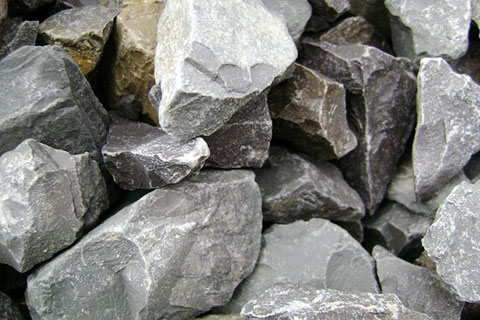



The main component of limestone is calcium carbonate (CaCO3), with a Mohs hardness of 3. It belongs to soft rock and is a common ore with chemical resistance, acid resistance, and low corrosion resistance. It is a soft material that can be used to produce glass, coating materials, desiccants, and raw materials required for construction after processing.
The limestone aggregate production line is divided into three stages: coarse crushing, medium and fine crushing, and screening.
Phase 1: Coarse crushing
The limestone material blasted from the mountain is uniformly fed by a vibrating feeder through the material bin and transported to a jaw crusher for coarse crushing.
Phase 2: Medium to fine crushing
After coarse crushing, the material is sieved by a vibrating screen and transported by a belt conveyor to a impact crusher for intermediate and fine crushing.
Third stage: Screening
The finely crushed stones are transported to the vibrating screen through a belt conveyor to separate stones of different specifications. Stones that meet the customer's particle size requirements are transported to the finished material pile through a belt conveyor. Stones larger than the upper screen size are returned to the impact crusher through a belt conveyor for further crushing, forming a closed loop.
The limestone sand making process is divided into four stages: coarse crushing, medium fine crushing, sand making, and screening.
Phase 1: Coarse crushing
The limestone material blasted from the mountain is uniformly fed by a vibrating feeder through the material bin and transported to a jaw crusher for coarse crushing.
Phase 2: Intermediate crushing
After coarse crushing, the material is sieved by a vibrating screen and transported by a belt conveyor to a impact crusher for intermediate crushing. The crushed stones are transported to the vibrating screen through a belt conveyor to separate stones of different specifications. Stones that meet the customer's particle size requirements are transported to the finished material pile through a belt conveyor. Stones larger than the upper screen size are returned to the impact crusher through a belt conveyor for further crushing, forming a closed loop.
Phase 3: Sand making
The crushed material, which is larger than the size of the second layer sieve, is transported by a belt conveyor to the sand making machine for fine crushing and shaping.
Stage 4: Screening
The material after fine crushing and shaping is then sieved through a circular vibrating screen for coarse sand, medium sand, fine sand and other specifications.
Note: For sand with strict requirements for powder content, a sand washing machine can be added behind the fine sand. The wastewater discharged by the sand washing machine can be recycled through the fine sand recovery device, reducing environmental pollution and increasing sand production.